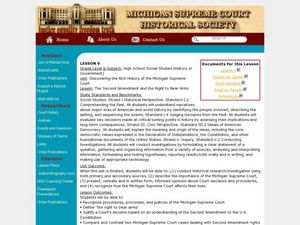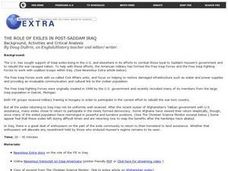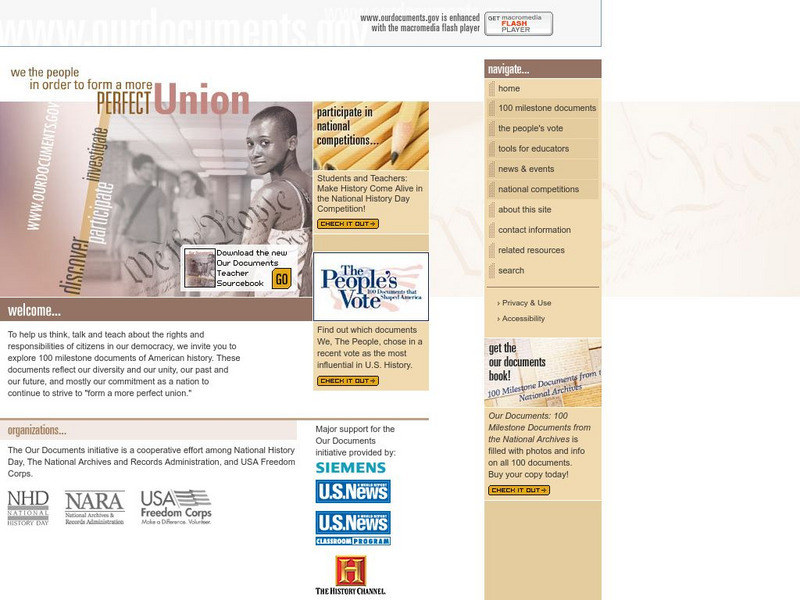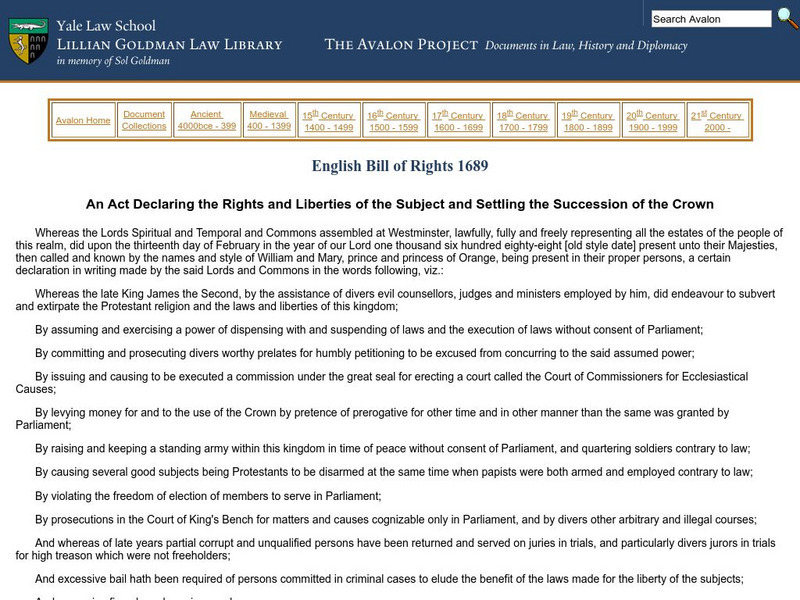Curated OER
Is the Internet Igniting Violence?
Students explain how various issues regarding restrictions on the Internet are impacted by the First Amendment of the United States Constitution, particularly in light of the recent school shooting and bombing in Littleton, Colorado.
Curated OER
McMUN Model United Nations
If you have been searching for a plan to run a model U.N. simulation, this plan provides some bare bones for your lesson. Scholars break into blocs to research and discuss global issues and come up with collaborative solutions. In their...
Curated OER
The Statue of Liberty: The Meaning and Use of a National Symbol
Engage your class in a series of activities, each related to the use or analysis of symbols used to convey patriotic or national concepts. They identify different national symbols and explain their meanings, discussing the importance of...
Curated OER
Now's the Time to Learn About the Ancient Greek Olympics
You can take advantage of the history of the Olympic Games to teach about the contributions of the Ancient Greeks.
Curated OER
Hut One, Hut Two ... Teams of the National Government: The Three Branches of Government
Eighth graders examine the three branches of government and the system of checks and balances.
Curated OER
The Second Amendment and the Right to Bear Arms
High schoolers interpret the Second Amendment. In this U.S. Constitution lesson, students examine the right to bear arms as they compare 2 Michigan Supreme Court cases and discuss their personal interpretations of the amendment.
Curated OER
It's Census Time: Census Lesson Plans
Census lesson plans can provide an interdisciplinary look at how the data is used, and what it means for everyone.
Curated OER
Michigan Court System (Part 1) (Middle School)
Students identify the courts that make up the Michigan judicial system. They explore the responsibility of each court and diagram how cases move to the Supreme Court. They compare and contrast the different types of courts.
Curated OER
Michigan Judicial System Conclusion
Middle schoolers identify the courts that make up Michigan's judicial system. They state the responsibilities of each court and diagram a flow chart of how a case moves to the Michigan Supreme Court. They participate in a quiz about the...
Curated OER
With Liberty and Justice for All
Fifth graders identify and define in their own words the first ten amendments to the Constitution. They are assigned a CDV or amendment from the Bill of Rights and create and present a one-minute skit demonstrating it.
Curated OER
The Second Amendment and the Right to Bear Arms
Students examine procedures and processes of the Michigan Supreme Court. They explain the Second Amendment to others. They compare and contrast two cases dealing with the Second Amendment.
Curated OER
Understanding the Importance of the Declaration of Independence
Eighth graders examine the importance of the Declaration of Independence
by using a variety of research sources and computer technology to obtain information. They internalize the thoughts, actions, and motives of the signers of the...
Curated OER
The U.S. and Iroquois Constitutions
Students receive and interpret copies of US Constitution and Iroquois Constitution. Then they reference (look up) the articles mentioned by Daly in the Iroquois Constitution text, and analyze for parallel meaning in the US Constitution....
Curated OER
Issues in Public Education During the Kentucky Civil Rights Era
Students conduct oral history interviews and research historical and contemporary media articles about multiculturalism and diversity.
Curated OER
Events Leading to the War of 1812
For this US History worksheet, students read a selection of the War of 1812 and fill in the blanks for 10 sentences using a word bank.
Curated OER
Create Your Own Constitution
Eighth graders explore the processes, purpose and components of a good and just constitution. They focus on the Constitution of the United States of America. Students discuss the purpose of a constitution and reasons why the Constitution...
Curated OER
The 1812 Louisiana Constitution
High schoolers analyze the Louisiana Constitution of 1812 and then draw up a constitution for their particular school. They compare the Louisiana Constitution to the United States Constitution of 1789 and create a graphic organizer of...
Curated OER
Corps of Discovery
Middle schoolers assess their knowledge of the Corps of Discovery through a written pretest, follow the journey of Lewis and Clark on the internet, record data on events, dates, places, people, animals, distance traveled, and geographic...
Curated OER
The Role of Exiles in Post-Saddam Iraq
Students study the role of exiles and refugees in Post-Saddam Iraq. Students are then asked the question: What could be some of the obstacles that exiles may encounter when working with the Iraqi civilian population?
US National Archives
Our Documents: A National Initiative on American History, Civics, and Service
Our Documents is home to one hundred milestone documents that influenced that course of American history and American democracy. Includes full-page scans of each document, transcriptions, background information on their significance, and...
Other
The Oas and the Inter American System
This site on the The OAS and the Inter-American System provides history, key dates, original and current member states, past and present secretaries general, and more.
OpenStax
Open Stax: Common Sense: From Monarchy to an American Republic
After reading this section from a chapter on "Creating Republican Governments," students will be able to compare and contrast monarchy and republican government and describe the tenets of republicanism.
Ohio Test Prep
Ohio Test Prep: Module 3: Historical Documents
Ohio test preparation material on the important historical documents from which the principles of U.S. democracy are reflected. With video tutorials, practice, and assessment.
Yale University
The Avalon Project: The English Bill of Rights 1689
An electronic version of the original English Bill of Rights, written in 1689, which influenced the writings of Thomas Jefferson, Benjamin Franklin, and John Adams, and laid the basis for American Democracy and common law.

























